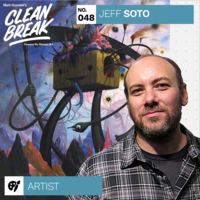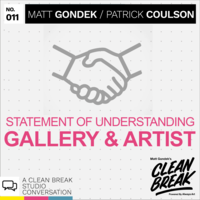Statement of
understanding:
Gallery & artist
- by Always Art Staff

The most essential qualities to establish for a successful partnership between a gallery and an artist are clear communication, collaboration, transparency, honesty, and realistic expectations. Whenever you are approaching a new relationship, it is best to build a statement of understanding to ensure you have all of those factors in place.

What is a statement of understanding?
It is a conversation and a document that outlines the roles and responsibilities of each party. It also helps to shape the commission conversation. We know this is a sensitive topic but advocating for transparency instead of unspoken and bottled-up thoughts is the best way to enter a business relationship. Furthermore, this document can ensure fair deals and provides something to fall back on when questions arise. It serves as protection for both the gallery and artist.
Navigating commission
There is no doubt that partnering with the right gallery can introduce artists to excellent opportunities and help sell artworks and advance their careers. Working through the details and getting a clear picture of the working relationship and roles helps foster trust and collaboration.
The balance of roles and what each side brings to the table helps to determine the gallery’s commission. The percentage you agree upon can vary depending on the services provided, where the artist is in their career, and the level prestige of the gallery. In the past, a commission was based on discovery, promotion, event marketing, an opening reception, catalog creation, collector introductions, etc.
For instance, a new artist should not expect to receive a travel, food, and appearance fee for their show because the gallery is doing them a favor and helping establish their career and build credibility early on. Whereas an established artist brings credibility to the gallery and helps them make the sales—the roles reverse.
Negotiations about commission essentially start at 50:50 and go up and down based on career level and the services the gallery is providing. The way you approach these questions as an artists can greatly affect the relationship. Galleries want artists who are easy to work with, help the process, and do not want everything handed to them. You should show that you are excited to grow and to help the gallery grow and succeed.
Consider that both of you are a team. In this case, you each have your primary jobs but for this show you are aligned, you both should be working together to make it a success. If each party is not fully engaged, you are only hurting one another and building resentment.

What to discuss with the gallery
The questions below are a good starting point and areas that should be discussed. Getting answers to these questions will ensure there are no misunderstandings. If you document the answers, they show the fairness of the partnership and can be used to shape the commission conversation.
The 50:50 commission structure was formed in the past and a lot has changed in the last 25 years of the art world. Both artists and galleries are trying to figure out how these changes affect their businesses. The internet, social media, and mobile phones have all transformed our businesses and the conversation about commission structure has ensure the workload is equitably distributed.
Artists, be professional in your collaboration with galleries. That includes respecting your due dates, being responsive, and not pitching yourself against them. Galleries, nurture your artists, do everything within your power to help them, and make sure the business relationship is fair based on services rendered (not traditional).
Before the agreement
- Research one another
- See if you are a good fit
- Artists: make sure the gallery’s member artists are in the same genre as you, and that their collectors match your intended audience
- Galleries: look at the artist’s works and make sure they are good fit for your gallery
- Try to verify if there is a shared collector base
- Do back-channel referrals
- Look at past shows

General questions to discuss
Show-related
(This can be for one time shows or general agreements that include future shows)
- When is the show?
- Where is the show?
- Is it a solo show? Group show? Wall?
- How many pieces are in the show?
- General sizes?
- Who prices the works?
- Is there going to be a print? What is the commission on the print? (Commission is after the expense of producing)
- Who produces the print?
- Edition size?
- Edition price?
- Is there an exclusivity period? How long? What does it cover?
Logistics
In the ideal world, the gallery should pick up all expenses post-creation of the works. The artist’s job is to produce the work and make it ready for sale. This includes renting the studio space, buying the materials (paint, canvas, easels, tools, etc.), and producing the work. The gallery’s job is to take it from that point and sell the work, that is an equitable distribution of work and tradition. The commission percentage can slide, and offerings differ based on the artist’s career level and current momentum. This is a business for both sides, conversations need to happen, and compromises have to be made.

Ask the following questions:
- Who pays to get the works to the gallery?
- Rolled or stretched?
- If rolled, who pays for stretching?
- Are they going to be framed?
- Who pays for framing?
Marketing
Almost everything here is standard and should be provided by the gallery.
- How are you planning to promote the show: Local Media, magazines, podcasts, fairs, social?
- Are there going to be window / wall elements? Who is paying for those?
- Will there be a show catalog?
- Will there be individual tear sheets?
- Is there going to be an opening reception? Who is paying for that?
- Is there a sponsor? Does that sponsor align with your vision / values?
Appearance
This is a sliding scale, where typically a newer artist should not expect these services and fees to be provided, whereas a successful and established artist should have all of these expenses covered. This is because the value proposition changes as the artist increases in notoriety. If each show is selling out and the artist’s recognition is growing, the gallery should realize the relationship and benefits are warranted even if they had not been provided in the past.
- Do you want the artists in attendance?
- Who covers travel to and from?
- Who covers food?
- Who covers lodging?
opening night!
After show and payment
These are the most sensitive topics but they are critical so there are no misunderstandings.
- Do you typically discount a work to make a sale? What is the normal discount?
- What is an acceptable amount for you to discount before you have to ask the artists?
- Is the discount shared equally or does it come out of the gallery commission?
- How long after the show before payment is received?
- How long do you hold the works after the show (typically 3 months - on walls or in the back room?)
- What is the percentage if the artist makes the sale?
- How long until I get paid after each post show sale?
- Who pays for shipping the work back?





